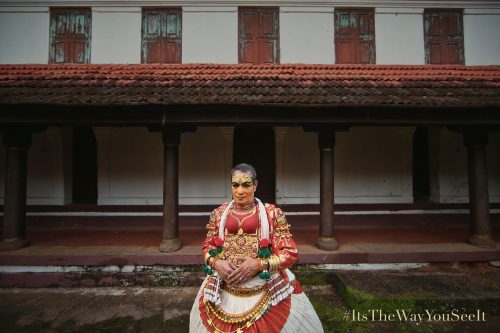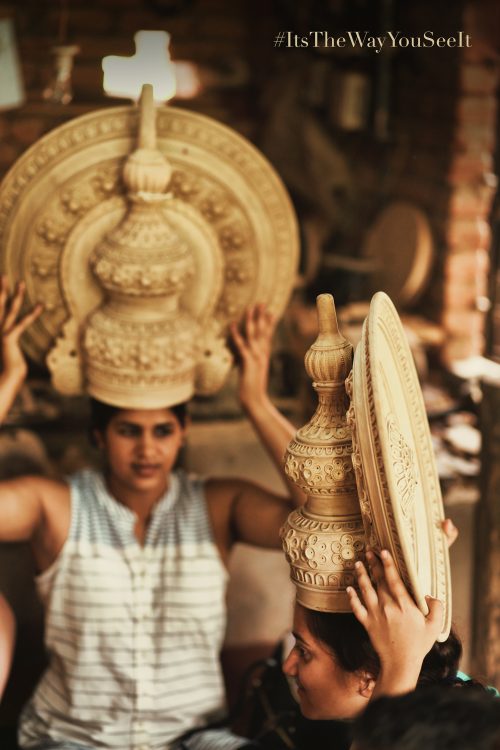TBI Blogs: This Organisation Is Using Responsible Tourism to Keep Alive the Rich Culture of Kerala’s River Nila
Bharatapuzha, or River Nila in Kerala, is home to riverbank communities engaged in traditional occupations such as pottery, handlooms, puppetry & folk art.

Bharatapuzha, or River Nila in Kerala, is home to riverbank communities engaged in traditional occupations such as pottery, handlooms, puppetry and folk art.
It is said that true places are never found on any map; and this is true of Vellinezhi, a picturesque hamlet tucked in the western interiors of Palakkad district, in the south Indian state of Kerala. Winding our way through nature, culture, history and everyday life, it is here that I discover the richness and depth of experiences afforded to those who choose people over places.
Far off the tourist radar – and thankfully so – it is the people that still form the pulsating heart of this sylvan, rugged land. Their stories strike a chord, connecting us with the legacy of centuries-old traditions and culture.
The stories of some of the communities we meet begin somewhere in the 15th and 16th centuries; with the migration from across the Western Ghats and the Deccan Plateau, each culture brought with it rich legends, folklore, skills, lifestyle, language and festivities.

Binding the stories together is the visible influence of the Bharatapuzha River that originates in the Annamalai Hills in the Western Ghats in neighbouring Tamil Nadu. This majestic river – a perennial source of inspiration for writers and poets, artists and artisans – journeys through three districts in central Kerala before merging with the sea at Ponnani in Malappuram.
It is this link with Bharatapuzha, or River Nila as it is more commonly known, that brings me here to Vellinezhi on a journey to follow the river and celebrate the traditions and culture that spawned on its banks. Sketching out the history of the Nila and its influence in the socio-religious, cultural history of Kerala is Gopinath Parayil, whose inextricable bond with the Nila stems from his childhood days of growing up along its banks.
The Nila bears influences of Sufism from Yemen, he says, and has also been shaped by the footprints of expeditions and traders from Greece, China and Arabia:
“The flow of the Nila has therefore not just sustained arts and culture, but has created the very ethos of this region.”

For Gopinath Parayil, it was the death of his father and the subsequent funeral rites performed along the river bank that opened his eyes to the ecological damage created by long years of unchecked sand mining, construction of dams and deforestation.
“I had just returned from the UK in 2003 and all I found were parched river beds and shallow, sluggish pools of water,” he remembers. Understanding that a physical revival may not be possible, he was determined to bring back the positive memories of the Nila and revitalize its rich legacy by documenting the music, the traditions, rituals and art forms associated with the river. With this vision, he founded the not-for-profit Nila Foundation in 2004, after quitting his job in the UK.
The Nila Foundation worked with riverbank communities engaged in traditional occupations such as pottery, handlooms, puppetry, folk art, etc., to understand their bond with the river.

“It was when personal funds ran out that I began to look at a more sustainable funding support and toyed with the idea of using tourism as a tool to generate income,” says Gopinath.
The idea was to create a meaningful travel experience by intimately connecting travellers with local communities, their unique practices, customs and traditions. Thus was formed The Blue Yonder in 2004, which soon emerged as the trendsetter of responsible tourism in the world.
It is with The Blue Yonder that I set out to explore the cultural hotspots and heritage, in and around Vellinezhi. Personally, it was a revelation of sorts as the trip unveiled incredible new experiences and opened up refreshing perspectives of my home state that I had not seen before.
From being spellbound by the solo act performance of nangiarkoothu, a 1,500-year-old dance form conveyed through stylised dance movements, facial expressions and hand gestures; to the haunting melody that accompanies the visual narrative of paava kathakali or glove puppetry and watching a bare floor get transformed into a vast canvas for the Kalamezhuthu, a ritual art to propitiate the deity, this trip gave me the chance to stumble upon something new every day.
It was also in Vellinezhi that we had the honor of interacting with 68-year-old Ramankutty Kothavil, the sole surviving practitioner of the art of making the ‘koppu’ – the intricate headgear and accessories including bracelets, anklets, ornate vests and even weapons, that are integral to the staging of the traditional performing art forms of Kerala.

His charming smile and old world humility belie the fact that were it not for his artistry and workmanship, Kerala’s celebrated art forms such as Koodiyattom, Kathakali, Chakyarkoothu, Nangiarkoothu, Krishnanattam and Ottam Thullal would have been stripped of their stunning ensemble – the very element that breathes life into its characters on stage.
Near Thothapuzha, another tributary of the River Nila is where we meet 41-year-old Krishna Kumar, the only practicing bell-metal worker who makes the ‘Adakkaputhoor Kannadi,’ a glazed metal mirror unique to the region. We watch, mesmerised, as he pours a boiling liquid alloy of copper and tin into a wax-filled, kiln baked mud and clay mould with iron tongs and gloveless hands. It will take days of continuous polishing to transform the black, rough-textured pieces to eventually get the reflective surface the craft is renowned for.
Nothing can quite compare to the overwhelming experience of watching a power-packed Kathakali performance, depicting the slaying of Duryodhana, while seated in the ‘poomukham’ (portico) of the famed Olappamana Mana.

This centuries-old mansion of an illustrious Namboothiri (Kerala Brahmin) household, constructed in the vernacular architectural style, served as a fitting backdrop to the performance particularly because of its strong association with the perpetuation of Kathakali for more than 250 years. It was here that the Kalluvazhi Chitta (school), characterized by distinct eye and feet movements, was perfected and adopted as a refined style of the classical dance form.
And it is at Olapamanna Mana that we relish the simple but delicious vegetarian food prepared by our hostess who handpicked many of the ingredients from her backyard.
Vellinezhi was a fabulous treat for all the senses – a perfect blend of nature, music, rhythm, dance and exquisite flavours. Yet, we have only scratched the surface of the vignettes of life beneath the fabric that weaves Nila’s culture together.There are the mountains, forests, quaint villages, architecture, temples and the community of potters, shadow puppeteers, musicians, percussionists, folklorists, ritualists and many more that remain to be seen.
It wasn’t the magic of the Nila alone that we experienced on this three-day trip. Travelling with The Blue Yonder also enabled us to witness the basic tenets of responsible tourism in practice. Its support to the local community has been long-term.
By incorporating neglected folk art forms, craft traditions and musical skills into its travel itineraries and through the grant of annual fellowships and financial awards to those pursuing traditional arts and crafts, the pride the communities now take in preserving their cultural heritage is giving these art forms a longer lease of life, and consequently, helping rebuild their livelihoods.

At every step of the way – from our stay at homestays and savoring the delicacies of local cuisine to steering clear of touristy routes – it was the people of Vellinezhi who were the heart of our travel experience. And for allowing us to become a part of the magic and mystery of their landscapes, enriching our lives with their stories and histories, and grounding us in their eclectic culture, I will always remain grateful.
Sangeetha Swarup is a freelance writer based in Dubai, UAE.
Like this story? Or have something to share? Write to us: [email protected], or connect with us onFacebook and Twitter.
NEW: Click here to get positive news on Whatsapp!
If you found our stories insightful, informative, or even just enjoyable, we invite you to consider making a voluntary payment to support the work we do at The Better India. Your contribution helps us continue producing quality content that educates, inspires, and drives positive change.
Choose one of the payment options below for your contribution-
By paying for the stories you value, you directly contribute to sustaining our efforts focused on making a difference in the world. Together, let's ensure that impactful stories continue to be told and shared, enriching lives and communities alike.
Thank you for your support. Here are some frequently asked questions you might find helpful to know why you are contributing?


This story made me
-
97
-
121
-
89
-
167














